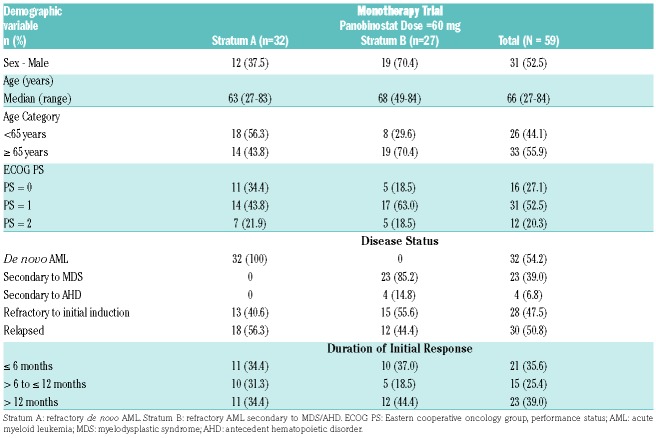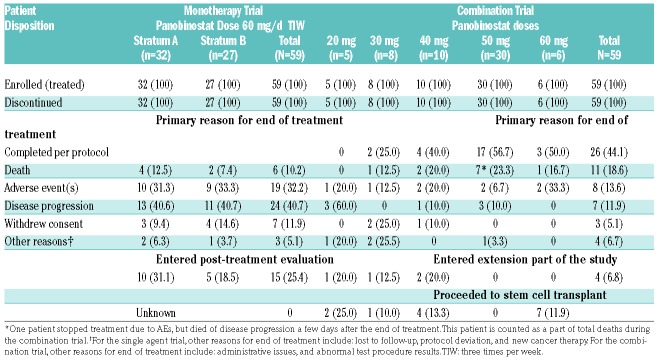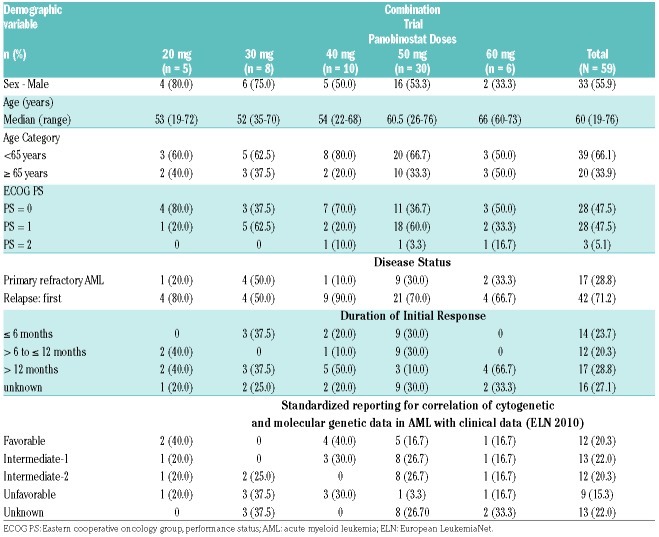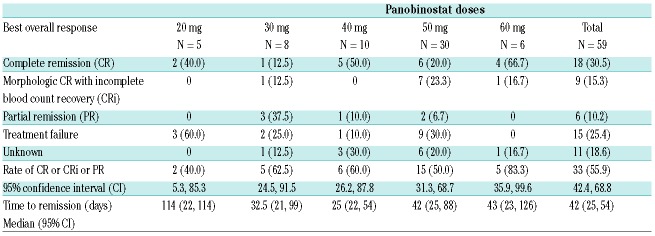Patients with acute myeloid leukemia (AML), who are refractory to induction therapy or experience relapse after a first complete remission (CR), have an unfavorable prognosis.1 Epigenetic dysregulation is frequent in AML. In preclinical studies, the pan-deacetylase inhibitor (DACi) panobinostat2 was shown to modulate the activity of multiple genes in leukemic cell lines,3 demonstrated single agent activity in AML cell lines and potentiated the activity of doxorubicin in preclinical assays.4 As a single agent, panobinostat showed modest anti-leukemic activity in early phase clinical trials in advanced hematological malignancies.5,6 In patients with myeloid disorders, 60 mg of panobinostat three times per week (TIW) as a single agent in weekly and biweekly schedules was defined as the maximum tolerated dose (MTD).
Based on this limited experience, we performed two clinical trials to evaluate the tolerability and clinical efficacy of panobinostat when given either as oral monotherapy at the previously established MTD, or in combination with intensive chemotherapy for relapsed or refractory (r/r) AML. Panobinostat monotherapy with 60 mg TIW for 28 days (one cycle) was evaluated in a phase II clinical trial following Simon’s optimal two-stage design in two strata: A) patients with de novo AML, and B) patients with secondary AML. The second study was a phase I study addressing whether panobinostat could be safely combined with Ara-C and mitoxantrone in r/r-AML in escalating doses in adult patients (age ≥ 18 years) with r/r AML. In the dose escalation step, oral doses of panobinostat (20 mg, 30 mg, 40 mg, 50 mg, and 60 mg, TIW) were given with fixed dose Ara-C (0.5 g/m2 intravenously (IV) twice daily, days 1–6) and mitoxantrone (5 mg/m2 IV, days 1–5) for three 28-day cycles. Patients with CR or complete remission with incomplete blood count recovery (CRi) were eligible for maintenance therapy with oral single agent panobinostat at 60 mg TIW. An adaptive Bayesian logistic regression model for combination therapy, including the escalation with overdose control principle, was used to guide the dose escalation of panobinostat.7 The MTD was determined by dose limiting toxicities (DLTs) in patients who had taken sufficient study drug (at least five doses of panobinostat in cycle 1) and had sufficient safety evaluations or discontinued due to dose-limiting toxicity (DLT) in cycle 1. Adverse events (AEs) were evaluated throughout both studies according to the common terminology criteria for adverse events (CTCAE), version 3.0.8 Response was evaluated according to Cheson’s criteria,9 based on investigator’s assessment of response.
In the monotherapy study 59 patients with a median age of 66 years (range: 27–84) were enrolled, 32 in Stratum A and 27 in Stratum B. Baseline characteristics are shown in Table 1 (A: monotherapy study; B: combination therapy study). All patients discontinued the study (Table 2), primarily for disease progression (24, 40.7%), AEs (19, 32.2%) and death (6, 10.2%). Fifteen patients (25.4%) entered post-treatment evaluation after six cycles of therapy and continued to be followed after treatment ended. Overall, 43 patients (72.9%) were exposed to panobinostat for < 8 weeks, the median overall exposure was 33 days. The median cumulative dose of panobinostat was 600 mg; Stratum A = 652.5 mg and Stratum B = 600 mg. The median dose intensity of panobinostat was 22.5 mg/day. The median overall relative dose intensity (RDI) was 85.7%; Stratum A = 80.0% and Stratum B = 100%. All 59 patients treated with panobinostat monotherapy experienced at least one AE, which was suspected to be related to the study drug in 53 patients (89.9%). The most common grade ≥ 3 AEs suspected to be related to the study treatment were reported in 34 (57.6%) patients. In both strata, the most common all grade AEs suspected to be study drug-related included diarrhea (62.7%), nausea (40.7%), thrombocytopenia (30.5%), decreased appetite (27.1%), and vomiting (23.7%). Overall, 52 patients (88.1%) experienced serious AEs (SAEs), and of these, SAEs were suspected to be study drug-related in 23 patients (38.9%). The most frequent grade ≥ 3 SAEs in both strata included thrombocytopenia (16, 27.1%) and febrile neutropenia (9, 15.3%). Overall, 42 patients died in the study, and in the majority of cases death was due to disease progression; overall survival after one and two years were 12% and 0%, respectively. For panobinostat monotherapy, the stage 1 review of best response for 26 patients in Stratum A revealed only one patient with a CRi, and for the 26 patients in Stratum B, one CR and one CRi. Therefore, enrollment to study was halted. Based on the final analyses of all enrolled patients, the CRR (CR/CRi) was 3.1% and 7.4% in Stratum A and Stratum B, respectively. All patients who responded had normal cytogenetics.
Table 1A.
Baseline patient demographics and disease characteristics for all patients enrolled in panobinostat monotherapy trial.
Table 2.
Patient disposition for the monotherapy and combination trials: primary reasons for end of treatment.
In the combination therapy study, 59 patients (median age 60 years, range: 19–76) were enrolled into the following panobinostat dosing cohorts: 20 mg (5 patients), 30 mg (8 patients), 40 mg (10 patients), 50 mg (30 patients), and 60 mg (6 patients); baseline characteristics are summarized in Table 1B. The treatment during the dose escalation and dose expansion part of the study was completed as per protocol by 26 patients, while 33 patients discontinued prematurely, mainly due to death (n=11), adverse events (n=8), or disease progression (n=7). Four patients entered the single agent extension part of the study and seven patients proceeded to stem cell transplantation (SCT). The majority of patients (78%) received panobinostat for one treatment cycle, whereby the median cumulative dosing was six doses and the median duration of exposure was 12 days for all dosing cohorts. The relative dose intensity was 1, indicating that the planned dose intensity corresponded to the received dose intensity. A total of 13 patients received two cycles of study treatment, and three patients in the 50 mg (n=2) and 60 mg (n=1) cohorts received three cycles. Of the 59 patients enrolled, 34 were evaluable for MTD determination. A total of 14 DLTs were observed in six patients; none in the 20 mg and 30 mg dose groups, one in the 40 mg group (grade 4 sepsis and grade 3 tachycardia), two in the 50 mg group (grade 3 diarrhea, grade 3 corrected QT interval derived from Fridericia’s formula (QTcF) prolongation, grade 3 nausea, grade 3 toxic exanthema, grade 3 vomiting) and three in the 60 mg group (grade 4 sepsis, grade 3 neutropenic colitis, grade 3 worsening bilateral pneumonia, grade 3 diarrhea leading to hypokalemia, grade 3 pancytopenia, grade 3 hypokalemia). The MTD was determined to be 50 mg panobinostat in the study dosing schedule. The chance of either excessive or unacceptable toxicity at this MTD dose was calculated to be 5.9% (i.e., < 25%), while for 60 mg panobinostat, this was calculated to be 34.4% (i.e., ≥ 25%). All 59 patients treated with panobinostat combination therapy experienced at least one AE that was suspected to be related to study treatment in 93% of patients, and in 88% of the patients this was a grade ≥ 3 AE. The most common grade ≥ 3 non-hematologic AEs suspected to be related to the study treatment were diarrhea (20%), nausea (5%), vomiting (5%), hypokalemia (7%), and sepsis (5%). AEs led to study discontinuation in 19 patients (32%), and in 6 (10%) of these patients discontinuation was due to an SAE considered to be related to the study treatment. The most frequent AEs leading to discontinuation were sepsis, including septic shock and fungal sepsis (seven events), QT prolongation and hypokalemia (two events each). Eleven patients (19%) died during or within 28 days of completing treatment. The causes of deaths were sepsis (n=5), septic shock (n=2), fungal infection (n=1), candidiasis (n=1), acute respiratory distress syndrome (n=1) and intracranial hemorrhage (n=1). By investigator assessment, the overall response rate with the combination therapy was 56% (CR in 18 patients [31%], CRi in 9 patients [15%], and partial response (PR) in 6 patients [10%]). The response rate at the MTD (50 mg) was 50%, (CR, 20% plus CRi, 23% plus PR, 7%). Responses were seen at all dose levels of panobinostat without clear evidence of the dose response relationship (Table 3). Responses were seen exclusively in patients with the European LeukemiaNet (ELN) 2010 favorable- or intermediate-1 risk group as well as in patients with a first CR > 6 months. Taken together at the previously reported MTD dose of 60mg for single agent therapy, panobinostat was efficacious only in single cases and was poorly tolerated in patients with r/r-AML. Other DACi’s, such as vorinostat,10 belinostat,11 and entinostat12 also showed poor efficacy in AML when used as a single agent. The MTD of panobinostat in combination with mitoxantrone and cytarabine was found to be 50 mg thrice weekly, which was comparable to the MTD of 60 mg determined for single agent panobinostat. The addition of panobinostat did not significantly increase the rate of AEs. In two other studies13 evaluating panobinostat in combination with idarubicin and cytarabine within a standard 7+3 induction therapy the identified MTD was considerably lower (10mg and 20mg, respectively), suggesting a relevant drug-drug interaction between panobinostat and idarubicin that is not relevant in combination with mitoxantrone. A CR/CRi rate in the combination therapy study of 46% and an overall survival rate of 15% at four years do not indicate promising efficacy.1
Table 1B.
Baseline patient demographics and disease characteristics for all patients enrolled in the combination trial.
Table 3.
Best overall response as per investigator assessment for the combination trial, by initial dose group of panobinostat.
Supplementary Material
Footnotes
Funding: The studies were sponsored by Novartis AG, Basel and editorial support was provided by Sujata Swaminathan, Anamika Gulati, and Vinay Kumar Ranka (Scientific Service Practices, Novartis Healthcare Private Limited, Hyderabad, India).
Information on authorship, contributions, and financial & other disclosures was provided by the authors and is available with the online version of this article at www.haematologica.org.
References
- 1.Schlenk RF, Müller-Tidow C, Benner A, Kieser M. Relapsed/refractory acute myeloid leukemia, any progress? Curr Opin Oncol. 2017; 29(6):467–473. [DOI] [PubMed] [Google Scholar]
- 2.Morabito F, Voso MT, Hohaus S, et al. Panobinostat for the treatment of acute myelogenous leukemia. Expert Opin Investig Drugs. 2016;25(9):1117–1131. [DOI] [PubMed] [Google Scholar]
- 3.Liu HB, Urbanavicius D, Tan P, Spencer A, Dear AE. Mechanisms and potential molecular markers of early response to combination epigenetic therapy in patients with myeloid malignancies. Int J Oncol. 2014;45(4):1742–1748. [DOI] [PubMed] [Google Scholar]
- 4.Maiso P, Colado E, Ocio EM, et al. The synergy of panobinostat plus doxorubicin in acute myeloid leukemia suggests a role for HDAC inhibitors in the control of DNA repair. Leukemia. 2009;23(12):2265–2274. [DOI] [PubMed] [Google Scholar]
- 5.DeAngelo DJ, Spencer A, Bhalla KN, et al. Phase Ia/II, two-arm, open-label, dose-escalation study of oral panobinostat administered via two dosing schedules in patients with advanced hematologic malignancies. Leukemia. 2013;27(8):1628–1636. [DOI] [PubMed] [Google Scholar]
- 6.Giles F, Fischer T, Cortes J, et al. A phase I study of intravenous LBH589, a novel cinnamic hydroxamic acid analogue histone deacetylase inhibitor, in patients with refractory hematologic malignancies. Clin Cancer Res. 2006;12(15):4628–4635. [DOI] [PubMed] [Google Scholar]
- 7.Babb J, Rogatko A, Zacks S. Cancer phase I clinical trials: efficient dose escalation with overdose control. Stat Med. 1998;17(10):1103–1120. [DOI] [PubMed] [Google Scholar]
- 8.Trotti A, Colevas AD, Setser A, et al. CTCAE v3.0: development of a comprehensive grading system for the adverse effects of cancer treatment. Semin Radiat Oncol. 2003;13(3):176–181. [DOI] [PubMed] [Google Scholar]
- 9.Cheson BD, Bennett JM, Kopecky KJ, et al. Revised recommendations of the International Working Group for diagnosis, standardization of response criteria, treatment outcomes, and reporting standards for therapeutic trials in acute myeloid leukemia. J Clin Oncol. 2003;21(24):4642–4649. [DOI] [PubMed] [Google Scholar]
- 10.Schaefer EW, Loaiza-Bonilla A, Juckett M, et al. A phase 2 study of vorinostat in acute myeloid leukemia. Haematologica. 2009; 94(10):1375–1382. [DOI] [PMC free article] [PubMed] [Google Scholar]
- 11.Kirschbaum MH, Foon KA, Frankel P, et al. A phase 2 study of belinostat (PXD101) in patients with relapsed or refractory acute myeloid leukemia or patients over the age of 60 with newly diagnosed acute myeloid leukemia: a California Cancer Consortium Study. Leuk Lymphoma. 2014;55(10):2301–2304. [DOI] [PMC free article] [PubMed] [Google Scholar]
- 12.Prebet T, Sun Z, Ketterling RP, et al. Azacitidine with or without Entinostat for the treatment of therapy-related myeloid neoplasm: further results of the E1905 North American Leukemia Intergroup study. Br J Haematol. 2016;172(3):384–391. [DOI] [PMC free article] [PubMed] [Google Scholar]
- 13.DeAngelo DJ, Walker AR, Schlenk RF, et al. A phase 1b study of panobinostat in combination with idarubicin and ara-C in patients with high-risk acute myeloid leukemia. Blood. 2015;126(23):2553–2553. [Google Scholar]
Associated Data
This section collects any data citations, data availability statements, or supplementary materials included in this article.






